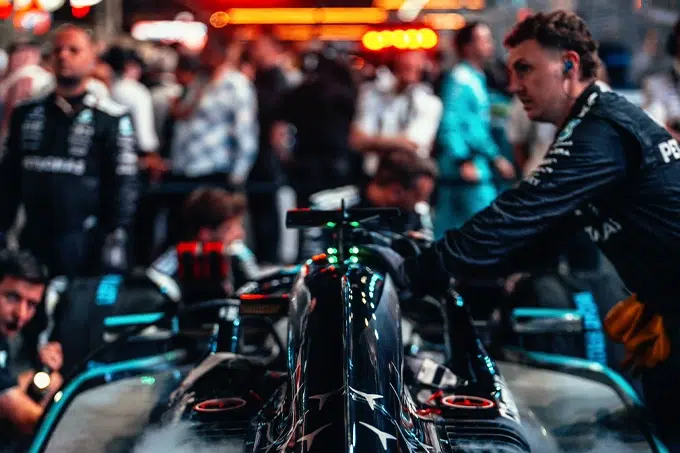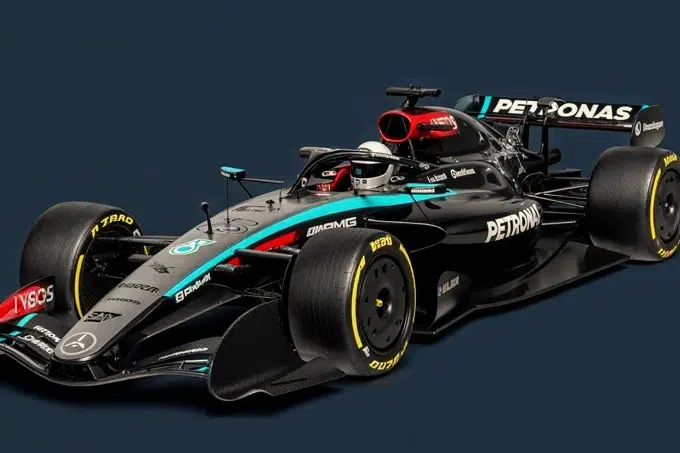Mercedes F1’s new engine regulations present major challenges, with months of hard work and recalibration ahead for the Brixworth team.
In Formula 1, there’s no time to waste in the engine departments. As the paddock debates potential changes to the 2026 regulations, such as fully sustainable fuel-powered power units, with an equal split between thermal and electric energy, there’s even talk of a possible return to V10 engines running on sustainable fuel by 2029 or 2031. Meanwhile, development for next year’s engines is moving full speed ahead.
Mercedes F1’s engine development team is not distracted by rumors or external discussions. After all, with Hywel Thomas taking over from Andy Cowell as the head of the engine department at Mercedes AMG High Performance Powertrains in Brixworth, there’s a tough job ahead. The challenge is to maintain the dominance Mercedes enjoyed in 2014, which left their competition far behind.
But is the 2026 engine overhaul as significant as the 2014 changes? Thomas doesn’t think so, but he emphasizes that the new V6 engines will represent a bigger transformation than many expect.
“It’s a complete redesign, which didn’t become as clear to me as it should have when the regulations were written,” he explained to The Race.
“Even though we’re keeping the V6, a turbo, an MGU-K, and a battery, which seem similar to what we have now, there are enough changes to reset everything. And that was the intention. To attract more manufacturers, a fresh start was necessary. So, absolutely everything is up for grabs.”
On paper, the 1.6L V6 turbo may seem unchanged, but the reality is much more complicated.
“There are major challenges with these regulations,” Thomas warns. “The V6 looks the same. Same displacement, same V-angle, same cylinder spacing, same bore. It might seem like the same engine. But there’s less fuel flow, a lower compression ratio, limited boost pressure, and the variable intake trumpets have been removed.”
“This completely changes the combustion regime. We’re basically starting from scratch. By the time we race, if not already, it won’t be a single part carried over from the current V6. Everything is new.”
The MGU-H, the most complex and costly component, will be removed, but the MGU-K will be pushed to new limits, handling 350 kW, equivalent to 470 hp.
“Back in 2009, we were at 60 kW. Now it’s 120. Soon, it’ll be 350. It’s a monster to manage,” Thomas adds.
“This is a massive change, a huge challenge, but also an exciting project, even if it causes a few grey hairs and explosions.”
However, Thomas points out that it’s not a total leap into the unknown, unlike in 2014.
“In 2014, we had to invent everything. The MGU-H didn’t exist. A 60-70 kW electric motor spinning at over 100,000 rpm, nothing like that existed. The batteries were new compared to the old KERS systems. We were starting from zero.”
“Now, a lot of things already exist, except the fuel. There are 350 kW EV systems available. We have thermal engines. So, it’s more about ambition than obligation.”
“Performance gains were mainly made in the thermal engine back then. Now, we really need to stay on top of the ERS (Energy Recovery System). We had more experience with thermal engines than hybrid systems.”
Is the Performance Gap Shrinking?
While there’s concern that the new engine regulations could further widen the performance gap between teams, particularly with the current tight competition, Thomas reassures F1 fans that the situation might not be as dire as it seems.
“The 2026 regulations are very prescriptive. The idea is to avoid the engine layout becoming a performance factor,” Thomas explains.
“The MGU must be at the front. The turbo needs to be at the back, all in a single unit. This kind of design rule forces us to focus on efficiency, not layout. And that’s much better for the sport.”
Another key change expected to bring the competition closer together is the engine budget cap.
Currently, manufacturers have $95 million per year for engine development until 2025, but starting in 2026, that cap will increase to $130 million.
“Today, we can’t spend more to make up for our problems. It changes how we approach the project,” Thomas notes.
Aligning the Chassis and Power Unit
One significant challenge will be aligning the chassis with the power unit, which has caused some friction between Mercedes’ teams in Brackley and Brixworth, admits Thomas.
“Our schedules are completely out of sync,” he acknowledges. “We’ve made decisions on our own with the best information available at the time. Now, teams are saying, ‘We don’t want that,’ and we have to undo what we’ve done.”
“We’ve got nine months of struggle ahead of us.”
Who Will Come Out on Top?
Many expect Mercedes F1, just like in 2014, to dominate the engine development race leading up to the 2026 regulations. But Thomas is cautious, as he has no crystal ball and is particularly wary of Ferrari. He also doesn’t rule out Honda or even Red Bull Powertrains, which reportedly has experienced delays in its development.
“We can’t know for sure. It’s pointless to listen to rumors. Even if we hear that one team is ahead or behind, we don’t know what that really means,” he says.
“Our approach has been the same for the last 15 years: head down, run as if we’re 10 kW behind, and figure out how to catch up.”
“Ferrari is a top-tier organization. They messed up in 2014, but they won’t do it again. Honda has won more titles than us in the last three years. They won’t mess up either. A newcomer could easily surprise us.”
“We have to act as if we’re 10 or 15 kW behind, or we’re dead.”
“If someone says a manufacturer is struggling with reliability, that doesn’t mean much. Maybe they’re pushing harder than anyone else. And besides, the engines we’re testing today aren’t the ones that will race in 2026.”
“We’ve been ambitious at times and had to go back and fix things or start over.”

- Discover More>Mexico’s F1 Deal Set for Extension Despite Perez Absence
- Follow us on >FACEBOOK and >TWITTERfor F1 update
F1’s 2026 Engines: Mercedes’ Bold Fight to Stay on Top F1’s 2026 Engines: Mercedes’ Bold Fight to Stay on Top
